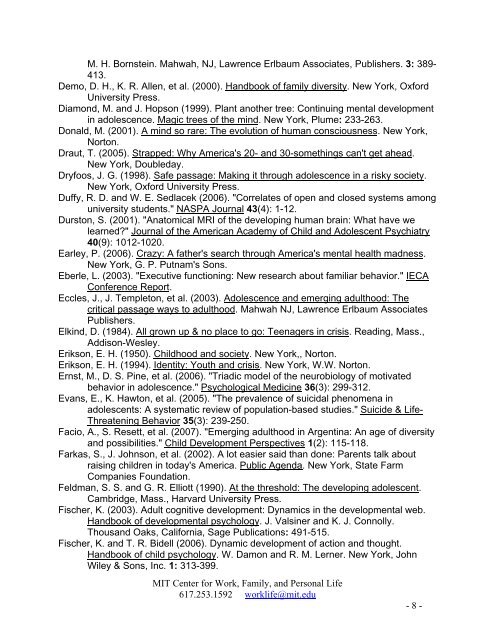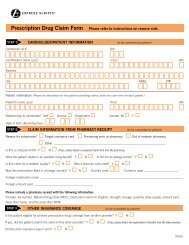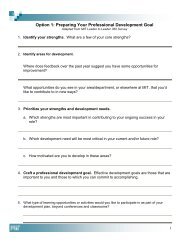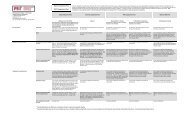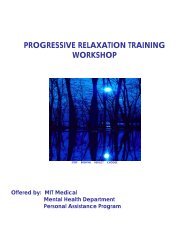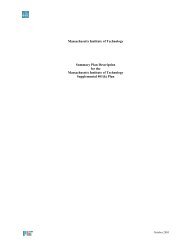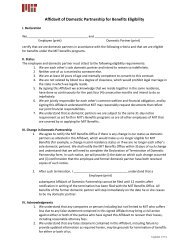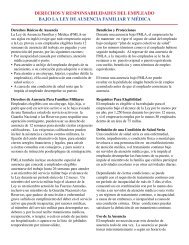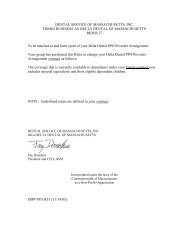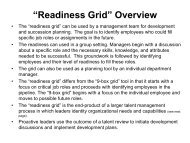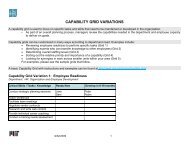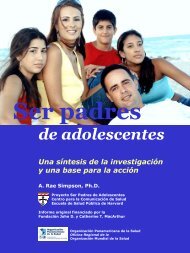M. H. Bornstein. Mahwah, NJ, Lawrence Erlbaum Associates, Publishers. 3: 389-413.Demo, D. H., K. R. Allen, et al. (2000). H<strong>and</strong>book of family diversity. New York, Ox<strong>for</strong>dUniversity Press.Diamond, M. <strong>and</strong> J. Hopson (1999). Plant another tree: Continuing mental developmentin adolescence. Magic trees of the mind. New York, Plume: 233-263.Donald, M. (2001). A mind so rare: The evolution of human consciousness. New York,Norton.Draut, T. (2005). Strapped: Why America's 20- <strong>and</strong> 30-somethings can't get ahead.New York, Doubleday.Dryfoos, J. G. (1998). Safe passage: Making it through adolescence in a risky society.New York, Ox<strong>for</strong>d University Press.Duffy, R. D. <strong>and</strong> W. E. Sedlacek (2006). "Correlates of open <strong>and</strong> closed systems amonguniversity students." NASPA Journal 43(4): 1-12.Durston, S. (2001). "Anatomical MRI of the developing human brain: What have welearned?" Journal of the American Academy of Child <strong>and</strong> Adolescent Psychiatry40(9): 1012-1020.Earley, P. (2006). Crazy: A father's search through America's mental health madness.New York, G. P. Putnam's Sons.Eberle, L. (2003). "Executive functioning: New research about familiar behavior." IECAConference Report.Eccles, J., J. Templeton, et al. (2003). Adolescence <strong>and</strong> emerging adulthood: Thecritical passage ways to adulthood. Mahwah NJ, Lawrence Erlbaum AssociatesPublishers.Elkind, D. (1984). All grown up & no place to go: Teenagers in crisis. Reading, Mass.,Addison-Wesley.Erikson, E. H. (1950). Childhood <strong>and</strong> society. New York,, Norton.Erikson, E. H. (1994). Identity: Youth <strong>and</strong> crisis. New York, W.W. Norton.Ernst, M., D. S. Pine, et al. (2006). "Triadic model of the neurobiology of motivatedbehavior in adolescence." Psychological Medicine 36(3): 299-312.Evans, E., K. Hawton, et al. (2005). "The prevalence of suicidal phenomena inadolescents: A systematic review of population-based studies." Suicide & <strong>Life</strong>-Threatening Behavior 35(3): 239-250.Facio, A., S. Resett, et al. (2007). "Emerging adulthood in Argentina: An age of diversity<strong>and</strong> possibilities." Child Development Perspectives 1(2): 115-118.Farkas, S., J. Johnson, et al. (2002). A lot easier said than done: Parents talk aboutraising children in today's America. Public Agenda. New York, State FarmCompanies Foundation.Feldman, S. S. <strong>and</strong> G. R. Elliott (1990). At the threshold: The developing adolescent.Cambridge, Mass., Harvard University Press.Fischer, K. (2003). Adult cognitive development: Dynamics in the developmental web.H<strong>and</strong>book of developmental psychology. J. Valsiner <strong>and</strong> K. J. Connolly.Thous<strong>and</strong> Oaks, Cali<strong>for</strong>nia, Sage Publications: 491-515.Fischer, K. <strong>and</strong> T. R. Bidell (2006). Dynamic development of action <strong>and</strong> thought.H<strong>and</strong>book of child psychology. W. Damon <strong>and</strong> R. M. Lerner. New York, JohnWiley & Sons, Inc. 1: 313-399.<strong>MIT</strong> <strong>Center</strong> <strong>for</strong> <strong>Work</strong>, <strong>Family</strong>, <strong>and</strong> <strong>Personal</strong> <strong>Life</strong><strong>617.253.1592</strong> worklife@mit.edu- 8 -
Fischer, K. W., J. H. Bernstein, et al. (2007). Toward a grounded synthesis of mind,brain, <strong>and</strong> education <strong>for</strong> reading disorders : An introduction to the field <strong>and</strong> thisbook. Mind, brain, <strong>and</strong> education in reading disorders. Cambridge, UK,Cambridge University Press: 1 - 22.Fischer, K. W. <strong>and</strong> S. P. Rose (1994). Dynamic development of coordination ofcomponents in brain <strong>and</strong> behavior: A framework <strong>for</strong> theory <strong>and</strong> research. Humanbehavior <strong>and</strong> the developing brain. G. Dawson <strong>and</strong> K. W. Fischer. New York,Guil<strong>for</strong>d Press: 3-66.Fischman, W. (2004). Making good: How young people cope with moral dilemmas atwork. Cambridge, Mass., Harvard University Press.Flanagan, C. A., J. M. Bowes, et al. (1998). "Ties that bind: Correlates of adolescents'civic commitments in seven countries." Journal of Social Issues 54(3): 457-475.Flavell, J. H. (2004). "Theory-of-mind development: Retrospect <strong>and</strong> prospect." Merrill -Palmer Quarterly 50(3): 1 - 12.Fontaine, C. <strong>and</strong> M. Fontaine (2006). Comeback: A mother <strong>and</strong> daughter's journeythrough hell <strong>and</strong> back. New York, ReganBooks.Fowler, J. (1980). Moral stages <strong>and</strong> the development of faith. Moral development, moraleducation. L. K. a. B. Munsey. Birmingham, Alabama, Religious Education Press.Fowler, J. W. (2000). Becoming adult, becoming Christian: Adult development <strong>and</strong>Christian faith. San Francisco, Jossey-Bass Publishers.Friedman, S. L. <strong>and</strong> T. D. Wachs (1999). Measuring environment across the life span:Emerging methods <strong>and</strong> concepts. Washington, DC, American PsychologicalAssociation.Friedman, T. L. (2007). The world is flat: A brief history of the twenty-first century. NewYork, NY, Picador.Frydenberg, E. (1997). Adolescent coping: Theoretical <strong>and</strong> research perspectives.London ; New York, Routledge.Fuligni, A. J. (2007). "<strong>Family</strong> obligation, college enrollment, <strong>and</strong> emerging adulthood inAsian <strong>and</strong> Latin American families." Child Development Perspectives 1(2): 96-100.Funder, D. C., J. Block, et al. (1993). Studying lives through time: <strong>Personal</strong>ity <strong>and</strong>development. Washington, DC, American Psychological Association.Furstenberg, F. F., R. A. Settersten, et al. (2005). On the frontier of adulthood: Theory,research, <strong>and</strong> public policy. Chicago, University of Chicago Press.Gabarino, J. (1999). Raising children in a socially toxic environment, Jossey-Bass.Galambos, N. L. <strong>and</strong> H. J. Krahn (2008). "Depression <strong>and</strong> anger trajectories during thetransition to adulthood." Journal of Marriage <strong>and</strong> <strong>Family</strong> 70(1): 15-27.Galambos, N. L. <strong>and</strong> M. L. Martinez (2007). "Poised <strong>for</strong> emerging adulthood in LatinAmerica: A pleasure <strong>for</strong> the privileged." Child Development Perspectives 1(2):109-114.Galinsky, E. (1987). The six stages of parenthood. Reading, Mass., Addison-WesleyPub. Co.Gallagher, R. P. (2005). National survey of counseling center directors. MonographSeries Number 8O. I. The International Association of Counseling Services,University of Pittsburgh.Galvan, A., T. A. Hare, et al. (2006). "Earlier development of the accumbens relative to<strong>MIT</strong> <strong>Center</strong> <strong>for</strong> <strong>Work</strong>, <strong>Family</strong>, <strong>and</strong> <strong>Personal</strong> <strong>Life</strong><strong>617.253.1592</strong> worklife@mit.edu- 9 -
- Page 1 and 2: MIT Young Adult Development Project
- Page 3 and 4: Barr, C. S., M. L. Schwandt, et al.
- Page 6 and 7: Chao, R. K. (2001). "Extending rese
- Page 10 and 11: orbitofrontal cortex might underlie
- Page 12 and 13: Harkness, S. and C. M. Super (1995)
- Page 14 and 15: on cognition in adolescent tobacco
- Page 16 and 17: of Cognition & Development 1(1): 11
- Page 18 and 19: 70(1): 256-257.Martin, C. A., T. H.
- Page 20 and 21: A. Thompson, A. I. Thompson and J.
- Page 22 and 23: Riera, M. (2003). Staying connected
- Page 24 and 25: adjustment." Personality and Indivi
- Page 26 and 27: Thompson, P. M., J. N. Giedd, et al
- Page 28: Zeigler, D. W. (2004). "The neuroco


